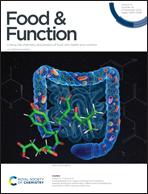The protective effects of sulforaphane on high-fat diet-induced metabolic associated fatty liver disease in mice via mediating the FXR/LXRα pathway
Abstract
Metabolic-associated fatty liver disease (MAFLD) is becoming the key factor in causing chronic liver disease all over the world. Sulforaphane (SFN) has been proven to be effective in alleviating many metabolic diseases, such as obesity and type 2 diabetes. In this study, C57BL/6 mice were fed a high-fat diet for 12 weeks to induce MAFLD and given SFN (10 mg per kg bw) daily. Our results showed that SFN not only improved the excessive accumulation of fat in the liver cells but also ameliorated liver and serum inflammatory and antioxidant levels. In addition, SFN can regulate bile-acid metabolism and fatty-acid synthesis by affecting their farnesoid X receptor (FXR)/liver X receptor alpha (LXRα) signaling pathway, ultimately alleviating MAFLD. Our study provides a theoretical basis for the mechanism by which SFN alleviates hepatic steatosis.



 Please wait while we load your content...
Please wait while we load your content...